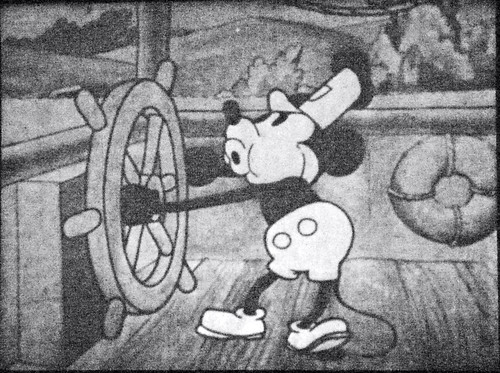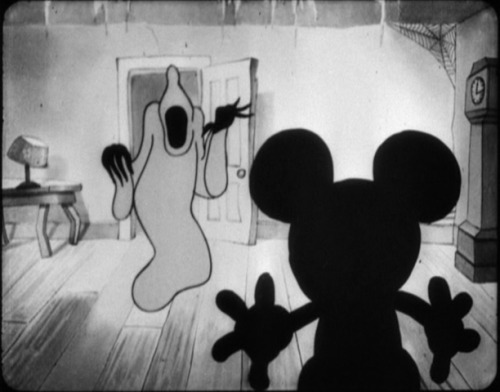Despite being twenty years of age and technically a legal "adult", I am a really huge fan of cartoons. I especially love the classic cartoons that were made in the 1920's and 1930's, from the likes of Max Fleischer and Walt Disney. I feel that, since these animated features weren't necessarily made to appeal to children, there was a lot more freedom accessible to these animators, in terms of characterization and overall content. One such character I have recently fallen in love with is one that is undoubtedly familiar to those who were at all exposed to American pop culture as a child; his name is Mickey Mouse.
Before Mickey's conception, Walt Disney had been making the rounds with Oswald the Lucky Rabbit, a character used for many animated films Disney made for distribution by Universal, who he worked for at the time. Oswald was a huge success in 1927, but by 1928, due to economic issues, the character was basically stolen by Charles Mintz. From here, Disney started his own studio and made a new character: an anthropomorphic mouse. He was originally named "Mortimer Mouse, but Disney's wife suggested "Mickey" would be a better fit.
Disney had the following to say about his new creation:
"We felt that the public, and especially the children, like animals that are cute and little. I think we are rather indebted to Charlie Chaplin for the idea. We wanted something appealing, and we thought of a tiny bit of a mouse that would have something of the wistfulness of Chaplin — a little fellow trying to do the best he could. When people laugh at Mickey Mouse, it's because he's so human; and that is the secret of his popularity. I only hope that we don't lose sight of one thing — that it was all started by a mouse." [source]Mickey is most notable for his mischievous personality (which, regrettably, has dwindled throughout the years), as well as his famous circular ears. He shares his popularity with girlfriend Minnie Mouse, and, in his early films, plays a role that is more like a suitor to Minnie than a hero. Here, I present a list of the films I have seen so far (thanks to Youtube!), plus a mini-synopsis and my rating for each.
- Plane Crazy (1928): Although Steamboat Willie is usually mistaken for being Mickey's first appearance, Disney did make two cartoons before it; Steamboat Willie was just the first to successfully retrieve a distributor. His true first appearance is actually in Plane Crazy. The highlights of this cartoon are Mickey's attempts at both flying a plane (á la Charles Lindbergh), and trying to retrieve a mid-air kiss from Minnie (who also makes her first appearance here). 3.5/5
- The Gallopin' Gaucho (1928): The second Mickey Mouse film produced (but not released). This cartoon starts with Mickey riding an ostrich to a restaurant, where he proceeds to drink and smoke. Conflict strikes when Black Pete attempts to kidnap Minnie, who is a barmaid. Pete and Mickey proceed to engage in a sword duel. The latter wins, and the two lovers ride off on the ostrich. 3/5
- Steamboat Willie (1928): The first Mickey Mouse film to be released, and also one of the first ever cartoons produced with synchronized sound, this cartoon is a parody of the Buster Keaton film Steamboat Bill Jr.. It is essentially plotless, and consists of pretty much Mickey the sailor and Minnie using various farm animals in humorous ways to create music. In my opinion, this is one of the first prime examples of Mickey's personality truly shining through. 4/5
- The Barn Dance (1929): Mickey and Pete unexpectedly meet in front of Minnie's house to pick her up for the dance. Due to car troubles, Minnie chooses to go with Mickey. At the dance, problems arise when it is apparent that Mickey can't dance and keeps stepping on Minnie's feet. He solves this by stuffing his shorts with balloons (making him "light on his feet"). The cartoon ends with Pete pointing this out to Minnie, who rejects Mickey and settles for Pete. Though this cartoon is rather humorous, it also plays down Mickey's personality, and the ending has him coming across as emotional and vulnerable. 3.5/5
- The Opry House (1929): Mickey owns a small theater and performs a one-man vaudeville show, with impressions and a piano performance. During the latter, he plays pieces such as "Yankee Doodle", Rachmaninov's "Prelude in C#minor", and Liszt's "Hungarian Rhapsody #2". There is essentially no dialogue, but Mickey's clash with the piano makes this a fun cartoon. 4/5
- When the Cat's Away (1929): A character by the name of Tom Cat leaves his house for the day, and Mickey proceeds to use his house to invite his mouse friends over to play music and dance. Some very innovative animation and characterization used here. 3.5/5
- The Plow Boy (1929): Mickey is a farmer plowing a field with his horse. Minnie and her cow comes onto the scene, with Minnie playing music. She asks Mickey to milk her cow. He does so, and then tries to kiss her to no avail. His horse is stung by a bee, who starts galloping and breaks the plow. In the final scene, Mickey proceeds to use a pig for a plow. Pretty funny and whimsical. 3.5/5
- The Karnival Kid (1929): This cartoon is divided up into two segments. In the first segment, Mickey is a hot dog vendor at a carnival, attempting to make sales. This segment is highly reliant on sight gags, and feature Mickey's first spoken words (voiced by Disney): "Hot dogs!"In the second half, which occurs later that night, Mickey joins in on a couple of stray cats in singing "Sweet Adeline" for Minnie. This is met by disapproval from another character nearby, trying to sleep. With scenes such as hot dogs behaving like actual dogs, this one was rather adorable. 3.5/5
- Mickey's Follies (1929): This cartoons presents a barnyard vaudeville-esque show, presented by the ducks, the chickens, a singing pig, and Mickey himself. Here, Mickey plays the piano, sings, and tap dances, though this performance isn't nearly as satisfying as in The Opry House. 3/5
- Mickey's Choo-Choo (1929): This short centers mostly around Mickey and his train, who has a face and even a unique personality, acting like a character of its own. After lunchtime and a musical interlude, Mickey takes Minnie along on a train ride. Unfortunately, the train finds difficulty in passing over a steep hill. Mickey tries to push it up, but the two end up breaking off the train and go tumbling down through several tunnels. They eventually end up on a handcar and ride away. Cute cartoon, but nothing very special. 3/5
- The Barnyard Battle (1929): This cartoon conveys a combat battle between the barnyard mice and an invading army of cats. At the beginning, Mickey is shown going through a physical examination, during which he is subject to humiliation. Mickey endures the battle with humor, and when the war ends, he is praised as a hero. This is also one of the more weaker cartoons I've seen thus far. 3/5
- The Jazz Fool (1929): Mickey, at the beginning, is shown playing the organ on a cart labeled "Mickey's Big Road Show". This first part centers around the farm animals dancing around to his music. Later, the cart becomes a stage, and Mickey continues to play music (this time on a piano), which stretches out to the end. Though the beginning is a bit dull, the piano-playing is more interesting and much more surreal than his more previous films. 3.5/5
- Jungle Rhythm (1929): In many of Mickey's previous films, there are scenes where Mickey essentially makes music with the animals he finds around him - by pulling a cat's tail or using their heads as drums, for example. This is pretty much what Jungle Rhythm is all about: Mickey is on a hunting expedition, and just when the animals are about to attack him, he orchestrates an entire song-and-dance. Nothing new or interesting here, except for the great example of Mickey's show of character. 3/5
- The Haunted House (1929): Mickey is lost and trapped in a ferocious storm, so he takes refuge in an abandoned old house. He soon finds out that it is haunted by ghosts and skeletons, who force him to play the organ as they dance. Those who have seen the Silly Symphonies cartoon The Skeleton Dance will recognize much of the reused animation used here. Still a fun short. 3.5/5
That's all for now! I'll be making posts every now and then for the next new batch of Mickey Mouse cartoons (1930-1931). I hope that I have compelled those who read these to check out some of these wonderful classic Disney cartoons!
[Note: all of the above facts that wasn't already known by myself have been retrieved from Wikipedia!]







No comments:
Post a Comment